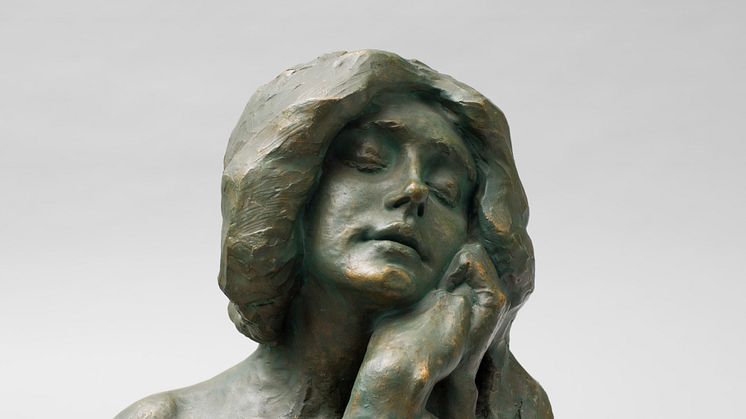
Press release -
Nationalmuseum acquires a sculpture by Alice Nordin
Nationalmuseum has acquired a sculpture created by the artist Alice Nordin. It is made of patinated plaster and depicts a woman resting the side of her face against her clasped hands. Research by the museum indicates that it is likely to be the sculpture A Memory from 1904.
The woman’s eyes are closed, but her upturned face bears an emotional expression. The style reflects the era’s taste for symbolism and Art nouveau, where dreamy expressions and soft lines were central components. The acquired sculpture is by Alice Nordin (1871–1948) and the museum has concluded that it is likely to be A Memory, which she created in 1904. Nordin herself stated that the model was the artist Gerda Nordling, who was a family friend.
The memory in question can be traced back to both a previously created work and a meeting. The meeting took place in Paris, where Nordin and Hugo Alfvén (1872–1960) met in the spring of 1898. She was a talented sculptor who had received a royal medal at the Royal Academy of Fine Arts in Stockholm; he was a young composer who was also in France to study on an academy scholarship. For a few months, the two had an intense love affair. Nordin wrote in her diary about their break-up, which was very painful for her. This meeting resulted in a bust of a woman with the same shape and expression as in A Memory: eyes closed, head back, as if listening to something. The sculpture was named Andante Patetico after the slow third movement of Alfvén’s violin sonata Op. 1, which he had premiered at his own soirée in Stockholm a couple of years earlier. It forms the basis of A Memory, which the artist created in 1904 and can today be found at the museum Kulturen in Lund.
In 1911 Nordin had a large solo exhibition at Konstnärshuset (the first for a female sculptor) and both Andante Patetico and A Memory were displayed together with some forty other sculptures. She was immensely popular at the time, and 3,000 visitors came and saw her exhibition. In the list of her works Nordin recorded late in life, she wrote of this period: “Now I have been gained a recognised name, quite a lot of money and at times a sense of calm in my troubled soul, and in a few happy moments also satisfaction for my hungry heart (which of course cannot last long).”
The ability to express emotion in art was often highlighted in the contemporary art criticism of female artists. Nordin was admired for her “lyrical sense” and she also understood the importance of creating and operating from this female sphere in order to gain acceptance; she was the sculptor who followed her feelings. But at the same time, her œuvre was so much more than that – she was innovative both in form and expression, and in her professional and personal life she was remarkably modern. She began her career as a student at the Technical School and then went on to the Academy of Fine Arts. There she received both the Ducal and Royal Medals, which enabled her to continue her studies in Paris. In the years that followed, Nordin lived a rather nomadic existence in Europe and participated in all major exhibitions from 1900 onward. The women’s magazine Idun published her travel stories, and this contributed to her immense popularity. Another reason for her success were her collaborations with Herman Bergman’s art foundry, Böhlmark’s lamp factory, and the Gustavsberg Porcelain Factory, which mass-produced her bronze and Parian ware sculptures. In 1905 Nordin was named Sweden’s foremost female artist in an Idun readers’ poll.
The museum’s collections currently include some 20 works by Alice Nordin, mainly sculptures in marble or cast bronze, but also figurines in Parian ware manufactured at the Gustavsberg Porcelain Factory. Several of them are important recent acquisitions for the exhibition Female Sculptors, which isplanned for the spring of 2022. Nationalmuseum receives no state funds with which to acquire design, applied art and artwork; instead the collections are enriched through donations and gifts from private foundations and trusts. The acquisition has been made possible by funds donated by Rurik Öberg.
Inventory number:
Alice Nordin, A Memory, 1904. Patinated plaster. NM Sk 2395.
For further information
Linda Hinners, Curator specialising in sculpture, linda.hinners@nationalmuseum.se, +46 (0)8 5195 4404
Hanna Tottmar, Head of Press, press@nationalmuseum.se, +46 (0)8 5195 4400
Nationalmuseum is Sweden’s museum of art and design. The collections include paintings, sculpture, drawings and graphic art from the 16th century up to the beginning of the 20th century and the collection of applied art and design up to the present day. The museum building closed for renovation in 2013 and reopened in autumn 2018.

